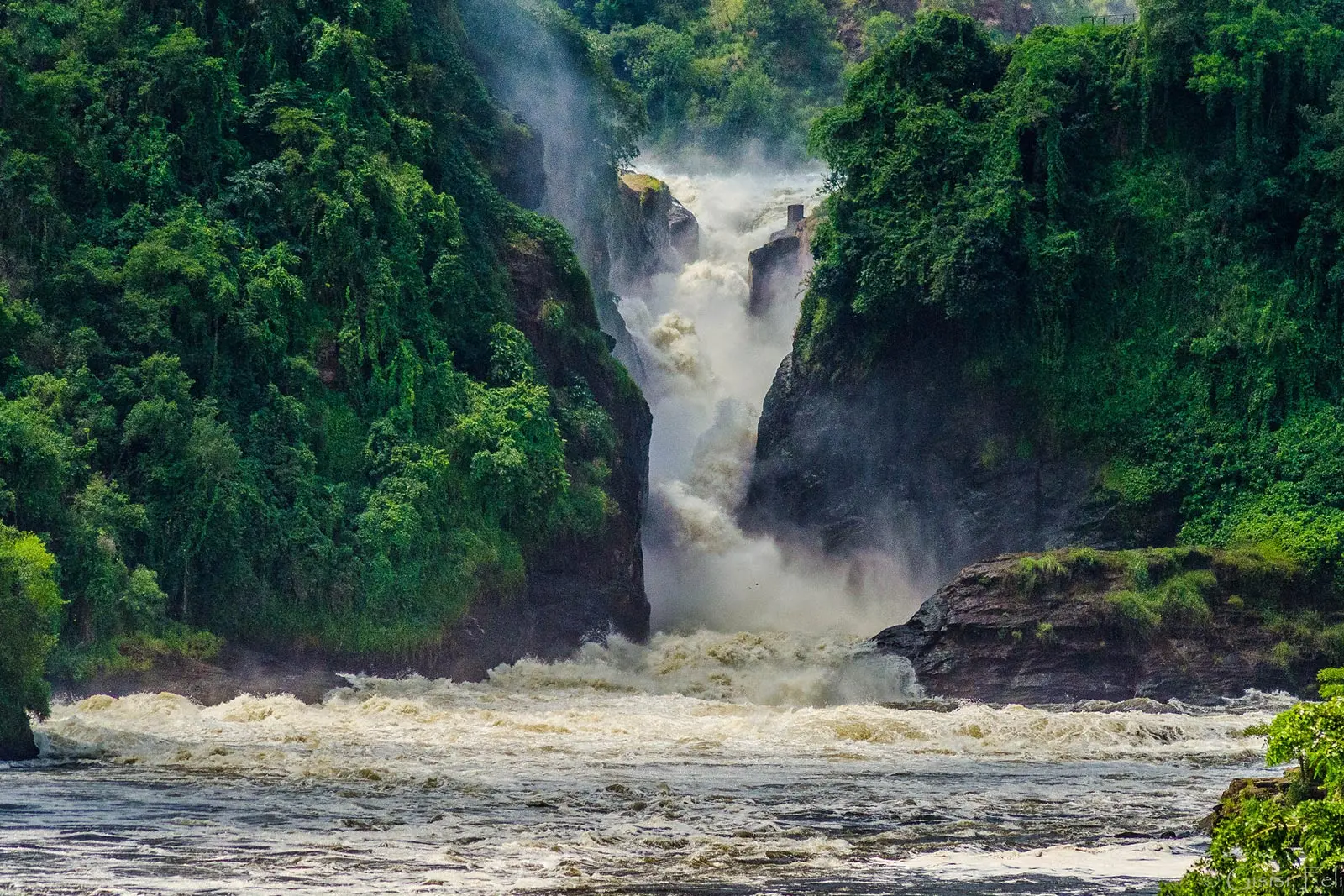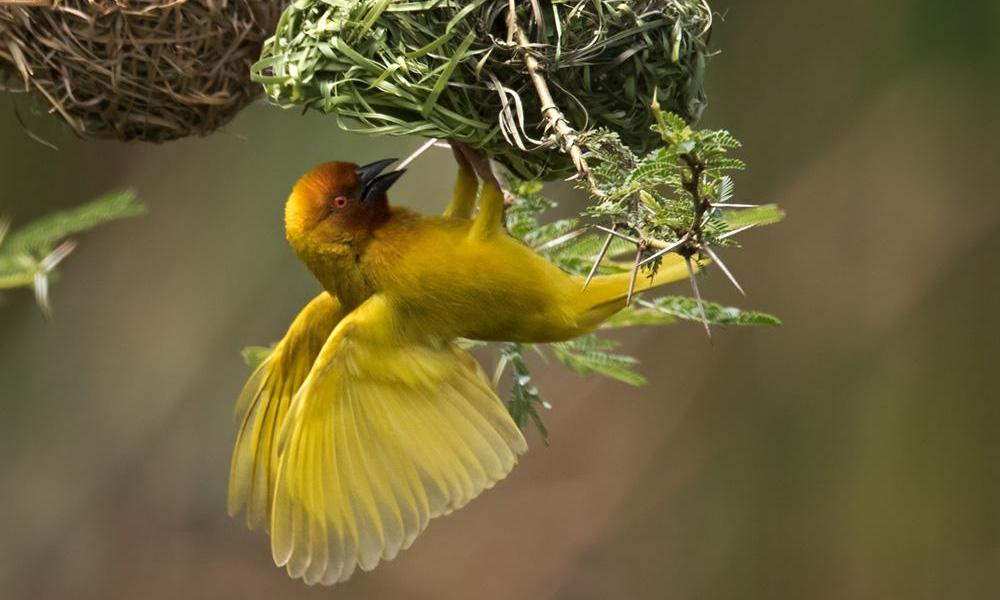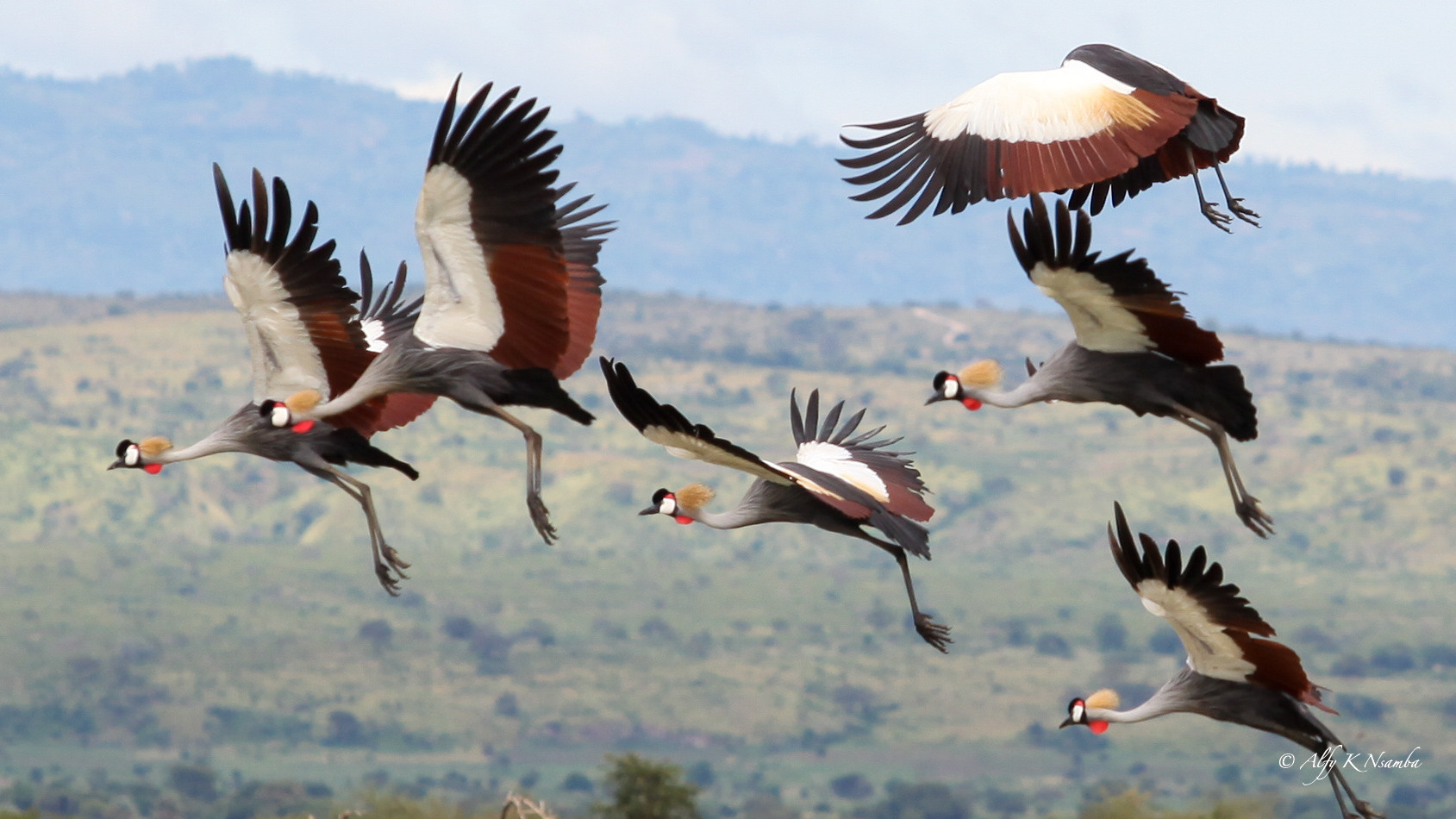Embark on an unforgettable journey with these Key Attractions In Queens Elizabeth National Park and discover its key attractions. Marvel at the sight of lions gracefully perched on trees in the Ishasha Sector, an incredible behavior found only in this park. Cruise along the Kazinga Channel and witness the fascinating interactions between wildlife and water, from the majestic hippos to the mighty elephants.
Whether you’re an avid explorer or a novice naturalist, Queen Elizabeth National Park offers something for everyone.
So take a deep breath, grab your binoculars and let’s go explore!
Kazinga Channel
Cruise along the Kazinga Channel for a breathtaking view of wildlife! The Kazinga Channel is one of the main attractions in Queen Elizabeth National Park, Uganda. It is located at the northern end of Lake Edward and connects it to Lake George.
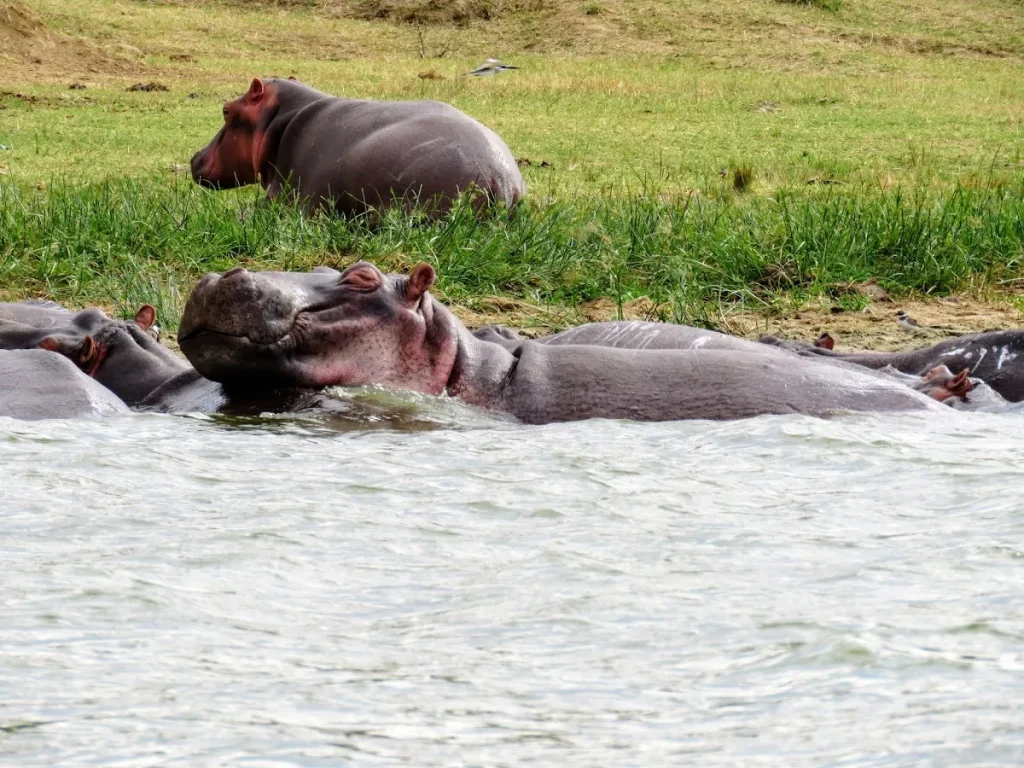
Boat tours are available to explore this area and witness a stunning variety of wild animals like hippos, elephants, buffaloes, crocodiles, warthogs, and birds. Whether you prefer a tranquil cruise or an adventurous game drive, there’s something for everyone here!
The beautiful scenery that surrounds the channel will make your jaw drop as you thrillingly watch large herds of African mammals swimming and playing around in their natural habitat. The perfect time to visit is around 6-7AM when the animals are most active during sunrise. This is also when you can get up close with some fascinating bird species such as fish eagles, kingfishers and cormorants!
Kazinga Channel offers an idyllic experience for all wildlife lovers out there. You can spend hours admiring these majestic creatures without ever getting bored – this truly makes it a unique destination in its own right!
To make sure you don’t miss out on any highlights from your safari adventure here at Queen Elizabeth National Park, be sure to book a boat tour before heading off towards Maramagambo Forest.
Maramagambo Forest
You’ll be amazed to learn that Maramagambo Forest is home to over 300 species of birds, making it an incredible place for birdwatching! The diverse ecosystem found in this forest offers a unique opportunity for wildlife viewing and eco tourism activities.
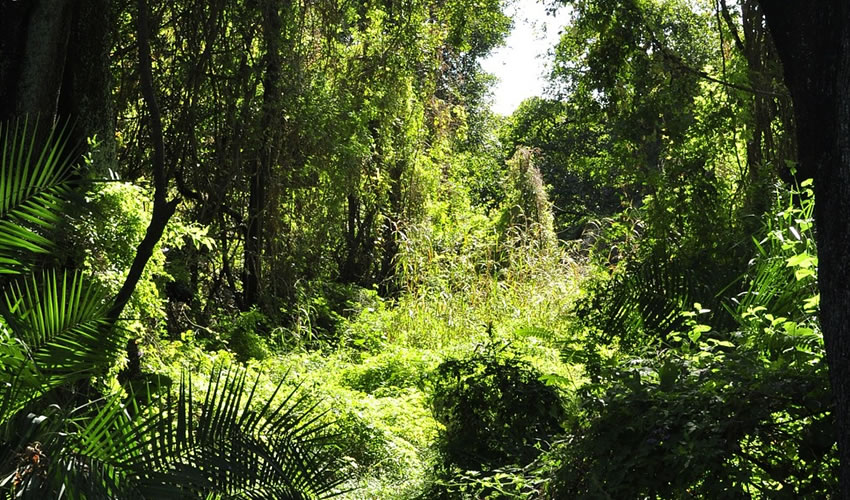
Visitors can find the following species of birds while visiting Maramagambo Forest:
| Name | Species | Description | Best Time to View |
|---|---|---|---|
| Great Blue Turaco | Corythaeola cristata | A large, vibrant bird with a blue, green, and yellow plumage. Known for its loud, distinctive calls. | Year-round |
| African Grey Parrot | Poicephalus erithacus | An intelligent parrot species known for its exceptional mimicking abilities. Has a gray body and red tail. | Year-round |
| Purple-breasted Sunbird | Nectarinia purpureiventris | A small, colorful bird with a purple breast and iridescent feathers. Feeds on nectar from flowers. | Year-round |
| African Emerald Cuckoo | Chrysococcyx cupreus | A slender bird with green and bronze plumage. Known for its distinctive call and parasitic nesting habits. | Year-round |
| Blue-breasted Kingfisher | Halcyon malimbica | A stunning kingfisher species with a blue and white plumage. Often seen perched near water bodies. | Year-round |
| Red-headed Bluebill | Spermophaga ruficapilla | A small, colorful bird with a red head and blue body. Often found in flocks feeding on seeds. | Year-round |
| Piping Hornbill | Ceratogymna fistulator | A large hornbill species with a black body, white belly, and a large curved bill. Known for its loud calls. | Year-round |
| White-spotted Flufftail | Sarothrura pulchra | A small, secretive bird with a brown plumage and white spots. Found in dense vegetation near wet areas. | Year-round |
| Black-and-white-casqued Hornbill | Ceratogymna subcylindricus | A medium-sized hornbill species with a black and white plumage and a large casque on its bill. | Year-round |
| Yellow-billed Barbet | Trachyphonus purpuratus | A colorful bird with a black, yellow, and red plumage. Often heard before seen due to its loud calls. | Year-round |
Maramagambo Forest also provides a habitat for many other animals such as chimpanzees, monkeys, snakes, and monitor lizards. Whether you’re searching for the elusive leopard or just looking to observe some fascinating primates, Maramagambo is an excellent destination.
Plus, with its impressive bird population and stunning natural beauty, it’s easy to see why it has become one of the most popular attractions in Queen Elizabeth National Park!
From here we move onto mammals—the next topic of discussion on our list.
Mammals
Marvel at the diverse range of mammals in Maramagambo Forest, including chimpanzees, monkeys, antelopes, and buffalo! The African Elephant is one of the biggest attractions in Maramagambo Forest. It’s majestic size is matched by its gentle demeanor. Buffalo Herds roam freely across the park and can often be seen from a distance. Hippopotamus Pool is another must-see spot for visitors; you can easily view these large mammals while they rest or play in the water.

| Name | Scientific Name | Description |
|---|---|---|
| African Elephant | Loxodonta africana | The largest land mammal, characterized by its long trunk and ivory tusks. |
| African Lion | Panthera leo | A majestic carnivore known for its distinctive mane and powerful roar. |
| African Buffalo | Syncerus caffer | A robust bovine species with large curved horns, often found in herds. |
| Leopard | Panthera pardus | A solitary and elusive big cat with a spotted coat and excellent climbing abilities. |
| Uganda Kob | Kobus kob thomasi | An antelope species with a reddish-brown coat and impressive curved horns. |
| Hippopotamus | Hippopotamus amphibius | A semi-aquatic mammal known for its massive size, barrel-shaped body, and large jaws. |
| Chimpanzee | Pan troglodytes | Our closest living relative, exhibiting high intelligence and complex social behaviors. |
| Giraffe | Giraffa camelopardalis | A graceful herbivore with a long neck and distinctive coat pattern. |
| Spotted Hyena | Crocuta crocuta | A scavenging carnivore recognized by its spotted coat and powerful build. |
| Topi | Damaliscus lunatus | An antelope species with a reddish-brown coat and long, curved horns. |
| Warthog | Phacochoerus africanus | A stout, pig-like mammal with prominent tusks and warty protrusions on its face. |
| Nile Crocodile | Crocodylus niloticus | A large and powerful reptile with a long snout, known for its ambush hunting style. |
| African Rock Python | Python sebae | A non-venomous snake that can reach impressive lengths and preys on a variety of animals. |
| Bushbuck | Tragelaphus scriptus | A medium-sized antelope with a reddish-brown coat and distinctive white markings. |
| Olive Baboon | Papio anubis | A social primate with an olive-brown coat and a dog-like face. |
| Defassa Waterbuck | Kobus ellipsiprymnus | A large antelope species with shaggy fur and characteristic white markings on its rump. |
| Black-and-white Colobus Monkey | Colobus guereza | A striking monkey with a black-and-white coat and long, flowing tail. |
| Spotted-necked Otter | Hydrictis maculicollis | A semi-aquatic mammal with a slender body and a spotted neck. |
| Oribi | Ourebia ourebi | A small antelope species with a reddish-brown coat and long, slender legs. |
| African Civet | Civettictis civetta | A nocturnal mammal with a cat-like appearance and distinctive facial markings. |
For a closer look at some of these amazing creatures, take one of the guided safari tours offered by Queens Elizabeth National Park. Guides will help you get up close to observe primates like baboons and colobus monkeys while also pointing out other animals such as elephants, antelope species and buffalos. This is a great opportunity to learn more about these incredible creatures in their natural habitat.
The best way to experience wildlife viewing within Maramagambo Forest is to spend time exploring different trails throughout the park. You’ll have an opportunity to spot some extraordinary species along your journey such as warthogs, giant forest hogs and hyenas. Whether you’re looking for a leisurely stroll or an exciting adventure off-trail – there’s something for everyone here! As you venture deeper into this lush rainforest paradise don’t forget to keep your eyes peeled – who knows what kind of sightings await?
From awe-inspiring elephants to playful primates – Queens Elizabeth National Park offers endless opportunities for wildlife discovery that are sure to leave lasting memories with visitors. With its vast array of mammal species, Maramagambo Forest provides an unforgettable experience unlike any other! Transitioning into reptiles now…
Reptiles
Discover the incredible reptiles of Maramagambo Forest, from monitor lizards to water snakes! Witness these awe-inspiring creatures in their natural habitat and marvel at the wonders of nature.

Reptiles are fascinating creatures and Queens Elizabeth National Park is home to a variety of them, including chameleons, crocodiles, and tortoises. The park offers visitors an unparalleled opportunity to observe reptile behavior while learning about their habitats.
| Name | Species | Description |
|---|---|---|
| Nile Crocodile | Crocodylus niloticus | A large, aquatic reptile with a powerful jaw and armored scales. Known for its ability to live in both freshwater and saltwater habitats. |
| Rock Monitor | Varanus albigularis | A large lizard species with a long body and distinctive markings. Often found basking in the sun on rocks and trees. |
| Leopard Tortoise | Stigmochelys pardalis | A large, terrestrial tortoise with a high-domed shell and distinct spots on its skin. Known for its slow movement. |
| Black Mamba | Dendroaspis polylepis | A highly venomous snake species with a sleek black body. Known for its aggressive behavior and deadly bite. |
| Chameleon | Chamaeleonidae family | A unique reptile known for its ability to change color. Has a long, slender body, a prehensile tail, and independently moving eyes. |
| Boomslang | Dispholidus typus | A venomous snake species with a slender body and large eyes. Known for its excellent climbing abilities. |
| Spotted Bush Snake | Philothamnus semivariegatus | A slender snake species with a greenish color and black spots. Often found in trees and shrubs. |
| Nile Monitor | Varanus niloticus | A large lizard species with a powerful tail and strong limbs. Often seen near water bodies and feeds on fish and small animals. |
| Puff Adder | Bitis arietans | A venomous snake species with a thick body and distinctive triangular-shaped head. Known for its defensive behavior and venomous bite. |
| Green Tree Python | Morelia viridis | A non-venomous snake species with a vibrant green color and a prehensile tail. Often found coiled on tree branches. |
In the forest, you may find Nile monitors searching for prey or see a cobra poised on a branch waiting for an unsuspecting meal. Every day brings something new as you explore this amazing ecosystem and get close to its reptilian inhabitants.
The wetland areas of the park also boast plenty of reptilian activity. Here it is quite common to spot turtles basking in the sun or even enormous crocodiles lurking just beneath the surface of the water. While exploring these wetlands, be sure to keep your distance so as not to disturb any animals that may be nearby. Additionally, if you’re lucky, you might glimpse some water snakes swimming gracefully through reeds or bask on logs near shorelines.
In addition to all these sights, there are many other surprises that await you during your visit to Queens Elizabeth National Park – just remember that when observing wildlife here, it’s important to respect their space and display proper etiquette at all times! As you explore this stunning environment, take time out from your journey and marvel at all its diverse forms of life – birds, mammals, amphibians, and reptiles alike – each playing an important role in this fragile yet vibrant ecosystem!
Birds
Take a break from the reptiles and witness the majestic birds of Maramagambo Forest! From parrots to eagles, there’s something for everyone to enjoy.

Queen Elizabeth National Park is home to over 600 species of birds, making it a paradise for bird watchers. Whether you take part in one of the many bird watching tours or spot them as you explore the park on your own, you’re sure to marvel at the vast array of migrating species that pass through each year.
| Name | Species | Description | Best Time to View |
|---|---|---|---|
| African Fish Eagle | Haliaeetus vocifer | A majestic bird of prey with a white head and chestnut body. Known for its distinctive call and fishing prowess. | Year-round |
| Giant Kingfisher | Megaceryle maxima | A large kingfisher species with a blue and white plumage. Often seen perched near water bodies. | Year-round |
| Malachite Kingfisher | Corythornis cristatus | A small kingfisher species with a vibrant blue and orange plumage. Often found near rivers and lakes. | Year-round |
| Grey Crowned Crane | Balearica regulorum | An iconic bird with a gray body, golden crown, and a long, elegant neck. Uganda’s national bird. | Year-round |
| Pied Kingfisher | Ceryle rudis | A small kingfisher species with a black and white plumage. Known for its distinctive hovering hunting technique. | Year-round |
| Hammerkop | Scopus umbretta | A unique bird with a large hammer-shaped head. Often seen near water bodies building large nests. | Year-round |
| African Skimmer | Rynchops flavirostris | A bird with a black and white plumage and a unique lower mandible. Skims the water surface to catch fish. | Year-round |
| Papyrus Gonolek | Laniarius mufumbiri | A striking bird with a black, red, and white plumage. Often found in papyrus swamps and wetland areas. | Year-round |
| Palm-nut Vulture | Gypohierax angolensis | A unique vulture species with a bald head and powerful beak. Feeds mainly on palm fruits and nuts. | Year-round |
| African Grey Hornbill | Tockus nasutus | A medium-sized hornbill species with a gray plumage and a distinctive red bill. Often seen in tree canopies. | Year-round |
There are plenty of opportunities for avid twitchers and novice birdwatchers alike; with common sightings including white-tailed larks, African skimmers, pink backed pelicans and much more. The Maramagambo forest may be particularly interesting if you’re looking out for raptors such as vultures and eagles which hunt around its edges.
The famous Kazinga channel also provides stunning views of kingfishers fishing along its banks while cormorants take flight above it. As dusk approaches, flocks of flamingos can often be seen taking off from their roosts in search of food in Lake George. In addition to these most commonly seen birds, keen-eyed visitors may catch a glimpse of rarer species like Ross’s turaco or black bee-eater within this unique ecosystem.
No matter where you go on safari in Queen Elizabeth National Park, there’s always an exciting avian experience just waiting to be discovered!
Moving on from birds, we’ll now explore amphibians found within the park…
Amphibians
Experience the diverse array of amphibians within Maramagambo Forest on your next journey! Located in Queen Elizabeth National Park, the wetland environment of this forest provides an ideal habitat for various species of amphibians.

With a variety of habitats including savannas and tropical forests, visitors can explore:
| Name | Species | Description |
|---|---|---|
| African Clawed Frog | Xenopus laevis | A medium-sized aquatic frog with claw-like projections on its hind feet. It has a flattened body and is often found in ponds and streams. |
| Common Toad | Bufo regularis | A terrestrial toad with a warty skin and a characteristic shape. It is found in various habitats, including forests and grasslands. |
| Green Tree Frog | Leptopelis viridis | A small arboreal frog with bright green coloration. It is well adapted for climbing trees and can be found in forested areas. |
| Painted Reed Frog | Hyperolius marmoratus | A small frog with striking colors and marbled patterns. It is typically found near water bodies and wetlands. |
| Common Reed Frog | Hyperolius viridiflavus | A small frog with a slender body and bright green or yellow coloration. It is commonly found in reed beds and wetlands. |
| Eastern Pygmy Toad | Pseudohynobius kuankuoshuiensis | A tiny toad species with a rounded body and short limbs. It is endemic to certain regions and can be found in humid environments. |
| Common Platanna | Xenopus laevis | A large aquatic frog with a flattened body and a preference for still or slow-moving water. It is known for its rapid growth and wide distribution. |
| Striped Marsh Frog | Limnodynastes peronii | A medium-sized frog with a dark brown coloration and distinctive stripes on its back. It is commonly found in marshy areas and near water bodies. |
| Eastern Lesser Snouted Frog | Pseudohynobius flavomaculatus | A small frog with a pointed snout and a preference for rocky habitats. It is known for its yellow and black coloration. |
| Common Squeaker | Arthroleptis variabilis | A small frog with a brown or gray coloration and a distinctive call resembling a squeak. It can be found in various forested habitats. |
Conservation efforts are important to protect these species and their wetland habitats as they face threats from human impact such as water pollution and deforestation. Research projects conducted by the National Park help to monitor population sizes and health of amphibian populations throughout the area, while education programs have increased local awareness about these delicate creatures and how best to conserve them for future generations.
Visiting Queen Elizabeth National Park provides the opportunity to observe aquatic life up close in their natural environment – something that cannot be experienced anywhere else in the world! Get ready to explore what lies beneath as you immerse yourself in this unique savanna ecology with all sorts of fascinating amphibians awaiting discovery around every corner!
And as you move on to explore fish within Uganda’s waters, keep an eye out for any other interesting wildlife!
Fish
Escape the hustle and bustle of everyday life and dive into Uganda’s waters to uncover its undiscovered fishy treasures! Queen Elizabeth National Park is home to an abundance of fish, which can be found in both saltwater and freshwater ecosystems.

The range of species is impressive: from the large Nile perch to smaller catfish, you’ll find all kinds of aquatic animals swimming around.
| Name | Species | Description |
|---|---|---|
| Nile Perch | Lates niloticus | A large predatory fish with a streamlined body and sharp teeth. Known for its significant size and weight. |
| Electric Catfish | Malapterurus electricus | A nocturnal fish capable of generating electrical discharges. Has a scaleless body and elongated whiskers. |
| Tiger Fish | Hydrocynus vittatus | A fierce, predatory fish with sharp teeth and distinctive black stripes on its body. Known for its agility and hunting skills. |
| Tilapia | Tilapia spp. | A group of freshwater fish known for their mild taste and adaptability. They come in various species, each with its unique characteristics. |
| Barbus | Barbus spp. | A genus of freshwater fish belonging to the carp family. They are known for their streamlined bodies and prominent barbels. |
| Haplochromis | Haplochromis spp. | A diverse group of cichlid fish found in East Africa’s lakes and rivers. They exhibit a wide range of colors and behaviors. |
| Nile Tilapia | Oreochromis niloticus | A species of tilapia known for its rapid growth and ability to tolerate various water conditions. Widely farmed for its economic value. |
| Clarias Catfish | Clarias spp. | A group of catfish species known for their eel-like appearance and air-breathing ability. Often found in stagnant or low-oxygen waters. |
| Bagrus Catfish | Bagrus spp. | A genus of large catfish found in freshwater habitats. They have long barbels and powerful jaws for capturing prey. |
| Protopterus | Protopterus spp. | A group of lungfish known for their ability to breathe air through a lung-like organ. They have elongated bodies and can survive in harsh conditions. |
Fishing regulations are strictly enforced in the park, so it’s important that visitors adhere to them. However, recreational fishing is allowed in certain areas with a valid permit. It’s also possible to hire experienced guides who will take you out on their boats for a day of angling fun.
Whether you’re looking for a leisurely afternoon or an adventurous excursion, Queen Elizabeth National Park has something for everyone! With its diverse array of fish species and stunning scenery, it makes for a truly unforgettable experience. So why not come explore this magical place today?
Frequently Asked Questions
What is the best time to visit Queens Elizabeth National Park?
The best time to visit Queen Elizabeth National Park is during the dry season, which runs from June to October. This is when wildlife viewing and bird watching are at their peak, with clear skies and plenty of sunny days ideal for exploring the park.
You’ll be able to spot large herds of elephants, lions, and antelope, as well as many different species of birds. The park also contains beautiful crater lakes where you can find unique species of fish.
Make sure you bring a good pair of binoculars so that you can get up close and personal with the wildlife without disturbing them!
Is there any accommodation available within the park?
Yes, there’s accommodation available within Queen Elizabeth National Park! You can choose from two different safari lodges that offer stunning views of the park’s wildlife.
These lodges provide comfortable and luxurious stays including access to hot showers and delicious African cuisine. The lodges are perfect for wildlife viewing, allowing you to get up close with some of the park’s incredible animals such as elephants, buffalos, and lions.
So if you’re looking for a special way to experience the beauty of Queen Elizabeth National Park, these safari lodges have it all!
Is there any special equipment that should be brought when visiting the park?
When visiting Queen’s Elizabeth National Park, it’s important to come prepared for wildlife viewing and eco tourism.
You’ll want to bring binoculars or a telephoto lens to get the best view of the animals.
A safari hat and sunscreen are also essentials to protect you from the sun.
Depending on your part of the park, you may need trekking boots and long-sleeved clothing for protection from insects and weather conditions.
Be sure to also bring plenty of water since dehydration can be a real danger in this environment.
Are there any safety precautions that should be taken when visiting the park?
When visiting Queens Elizabeth National Park, there’s one rule you need to remember: safety first! Whether you’re hoping to spot some of the local wildlife or get a glimpse of animals in their natural habitat, it’s important to be mindful of your surroundings and follow certain precautions.
To stay safe, always pack plenty of water and snacks for an energy boost. Stay on marked trails and paths so you don’t get lost. And choose brightly colored clothing that will help keep animals away.
As tempting as it may be to approach the animals for a closer look or take selfies with them, please remember that these are wild creatures – maintain your distance out of respect for them and yourself.
Have fun exploring all the key attractions at Queens Elizabeth National Park!
Are there any special events or activities available at the park?
You’ll find plenty of exciting activities and events at Queen Elizabeth National Park!
Wildlife spotting is a popular pastime here; you can take a safari and see elephants, hippos, lions, hyenas, and many other animals in their natural habitat.
Boat rides are also available for those who want to explore the park from the water. You’ll be able to experience incredible views of the park’s scenery and spot more wildlife on your ride.
Whether you’re looking for an adventure or just a relaxing day out, Queen Elizabeth National Park has something for everyone!
Conclusion
Queens Elizabeth National Park is a must-visit for nature lovers. There’s something to capture everyone’s heart with its stunning Kazinga Channel, lush Maramagambo Forest, and abundance of wildlife. You can enjoy a peaceful boat cruise or an adrenaline-filled game drive – this park has it all!
Don’t miss out on the incredible experience that awaits you here. It’s one that will stay with you for life. Plus, you’ll have bragging rights that you were able to see it all first hand. So, don’t delay any longer and start packing your bags! It’ll be worth your while in the end – guaranteed to be money well spent.

